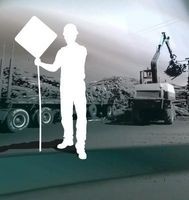Public Safety Checklist In A Construction Zone

Public safety in construction zones is an important consideration for construction companies from a legal and financial standpoint. If a citizen is injured on or near a job site, the company may be legally responsible for damages. While many county and municipal governments have regulations regarding public safety at construction sites, creating a public safety checklist for all job sites is a good step for construction companies to implement.
Identify Hazards
When planning your construction zone public safety checklist, you should first identify the hazards that might be present. Hazards can be described as environmental, structural, mechanical, electrical, chemical or biological. For example, an environmental hazard might be water that could spill into a roadway or pedestrian area and cause slips or motor vehicle accidents. A structural hazard could be a loose board that could fall, and a mechanical hazard could be an unsecured construction vehicle.
Design Safety Features
Based on the hazards you have identified, design safety features to prevent these hazards. These can be as simple as securing construction vehicles or ensuring that all construction materials are secure and won't tip, spill or fall on pedestrians. All safety features should have redundancy so that if one fails, another safety feature will prevent injuries to the public. Municipal governments will have regulations for public safety around construction zones, so make sure to follow those guidelines to the letter.
Signs
Signs warn the public of construction zones.
An important part of any public safety checklist is ensuring that proper signs are posted. Pedestrians and motorists can only avoid hazards if they are aware that they may exist. Workers should post signs indicating that there is a construction zone as well as signs relating to specific hazards. Be sure to post signs where they aren't covered up by traffic signs, trees, barricades or other objects like mail boxes or trash cans. Walk past your job site and check that all signs are visible.
Barricades
Barricades prevent the public from encountering hazards.
Sidewalks or other public areas that will be affected by a construction job should be barricaded so that pedestrians can't encounter hazards. Barricades should be orange or yellow and have reflective tape so that they can be seen during the day and at night. Lights can ensure visibility, but they may not be required. Barricades themselves should also be safe and not present a hazard. Always check with the local government agency regarding requirements for construction barricades.
Worker Visibility
Workers need to be visible to motorists and pedestrians.
All construction workers should be highly visible to both motorists and pedestrians. This is to protect not only construction workers but the public. Workers should wear safety vests in bright colors like orange or yellow, and all vests should have reflective tape for night visibility. Always replace worn or dirty vests so that workers are protected.
Identify Hazards
When planning your construction zone public safety checklist, you should first identify the hazards that might be present. Hazards can be described as environmental, structural, mechanical, electrical, chemical or biological. For example, an environmental hazard might be water that could spill into a roadway or pedestrian area and cause slips or motor vehicle accidents. A structural hazard could be a loose board that could fall, and a mechanical hazard could be an unsecured construction vehicle.
Design Safety Features
Based on the hazards you have identified, design safety features to prevent these hazards. These can be as simple as securing construction vehicles or ensuring that all construction materials are secure and won't tip, spill or fall on pedestrians. All safety features should have redundancy so that if one fails, another safety feature will prevent injuries to the public. Municipal governments will have regulations for public safety around construction zones, so make sure to follow those guidelines to the letter.
Signs
Signs warn the public of construction zones.
An important part of any public safety checklist is ensuring that proper signs are posted. Pedestrians and motorists can only avoid hazards if they are aware that they may exist. Workers should post signs indicating that there is a construction zone as well as signs relating to specific hazards. Be sure to post signs where they aren't covered up by traffic signs, trees, barricades or other objects like mail boxes or trash cans. Walk past your job site and check that all signs are visible.
Barricades
Barricades prevent the public from encountering hazards.
Sidewalks or other public areas that will be affected by a construction job should be barricaded so that pedestrians can't encounter hazards. Barricades should be orange or yellow and have reflective tape so that they can be seen during the day and at night. Lights can ensure visibility, but they may not be required. Barricades themselves should also be safe and not present a hazard. Always check with the local government agency regarding requirements for construction barricades.
Worker Visibility
Workers need to be visible to motorists and pedestrians.
All construction workers should be highly visible to both motorists and pedestrians. This is to protect not only construction workers but the public. Workers should wear safety vests in bright colors like orange or yellow, and all vests should have reflective tape for night visibility. Always replace worn or dirty vests so that workers are protected.
- 935ea242113add0e65acb3e9dd3d6a6c40.jpg